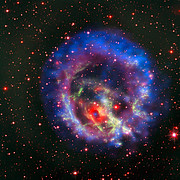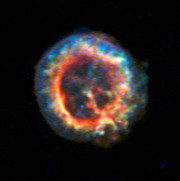Press Release
Dead Star Circled by Light
MUSE data points to isolated neutron star beyond our galaxy
5 April 2018

New images from ESO’s Very Large Telescope in Chile and other telescopes reveal a rich landscape of stars and glowing clouds of gas in one of our closest neighbouring galaxies, the Small Magellanic Cloud. The pictures have allowed astronomers to identify an elusive stellar corpse buried among filaments of gas left behind by a 2000-year-old supernova explosion. The MUSE instrument was used to establish where this elusive object is hiding, and existing Chandra X-ray Observatory data confirmed its identity as an isolated neutron star.
Spectacular new pictures, created from images from both ground- and space-based telescopes [1], tell the story of the hunt for an elusive missing object hidden amid a complex tangle of gaseous filaments in the Small Magellanic Cloud, about 200 000 light-years from Earth.
New data from the MUSE instrument on ESO’s Very Large Telescope in Chile has revealed a remarkable ring of gas in a system called 1E 0102.2-7219, expanding slowly within the depths of numerous other fast-moving filaments of gas and dust left behind after a supernova explosion. This discovery allowed a team led by Frédéric Vogt, an ESO Fellow in Chile, to track down the first ever isolated neutron star with low magnetic field located beyond our own Milky Way galaxy.
The team noticed that the ring was centred on an X-ray source that had been noted years before and designated p1. The nature of this source had remained a mystery. In particular, it was not clear whether p1 actually lies inside the remnant or behind it. It was only when the ring of gas — which includes both neon and oxygen — was observed with MUSE that the science team noticed it perfectly circled p1. The coincidence was too great, and they realised that p1 must lie within the supernova remnant itself. Once p1’s location was known, the team used existing X-ray observations of this target from the Chandra X-ray Observatory to determine that it must be an isolated neutron star, with a low magnetic field.
In the words of Frédéric Vogt: “If you look for a point source, it doesn’t get much better than when the Universe quite literally draws a circle around it to show you where to look.”
When massive stars explode as supernovae, they leave behind a curdled web of hot gas and dust, known as a supernova remnant. These turbulent structures are key to the redistribution of the heavier elements — which are cooked up by massive stars as they live and die — into the interstellar medium, where they eventually form new stars and planets.
Typically barely ten kilometres across, yet weighing more than our Sun, isolated neutron stars with low magnetic fields are thought to be abundant across the Universe, but they are very hard to find because they only shine at X-ray wavelengths [2]. The fact that the confirmation of p1 as an isolated neutron star was enabled by optical observations is thus particularly exciting.
Co-author Liz Bartlett, another ESO Fellow in Chile, sums up this discovery: “This is the first object of its kind to be confirmed beyond the Milky Way, made possible using MUSE as a guidance tool. We think that this could open up new channels of discovery and study for these elusive stellar remains.”
Notes
[1] The image combines data from the MUSE instrument on ESO’s Very Large Telescope in Chile and the orbiting the NASA/ESA Hubble Space Telescope and NASA Chandra X-Ray Observatory.
[2] Highly-magnetic spinning neutron stars are called pulsars. They emit strongly at radio and other wavelengths and are easier to find, but they are only a small fraction of all the neutron stars predicted to exist.
More information
This research was presented in a paper entitled “Identification of the central compact object in the young supernova remnant 1E 0102.2-7219”, by Frédéric P. A. Vogt et al., in the journal Nature Astronomy.
The team is composed of Frédéric P. A. Vogt (ESO, Santiago, Chile & ESO Fellow), Elizabeth S. Bartlett (ESO, Santiago, Chile & ESO Fellow), Ivo R. Seitenzahl (University of New South Wales Canberra, Australia), Michael A. Dopita (Australian National University, Canberra, Australia), Parviz Ghavamian (Towson University, Baltimore, Maryland, USA), Ashley J. Ruiter (University of New South Wales Canberra & ARC Centre of Excellence for All-sky Astrophysics, Australia) and Jason P. Terry (University of Georgia, Athens, USA).
ESO is the foremost intergovernmental astronomy organisation in Europe and the world’s most productive ground-based astronomical observatory by far. It has 15 Member States: Austria, Belgium, Czechia, Denmark, France, Finland, Germany, Italy, the Netherlands, Poland, Portugal, Spain, Sweden, Switzerland and the United Kingdom, along with the host state of Chile and with Australia as a strategic partner. ESO carries out an ambitious programme focused on the design, construction and operation of powerful ground-based observing facilities enabling astronomers to make important scientific discoveries. ESO also plays a leading role in promoting and organising cooperation in astronomical research. ESO operates three unique world-class observing sites in Chile: La Silla, Paranal and Chajnantor. At Paranal, ESO operates the Very Large Telescope and its world-leading Very Large Telescope Interferometer as well as two survey telescopes, VISTA working in the infrared and the visible-light VLT Survey Telescope. ESO is also a major partner in two facilities on Chajnantor, APEX and ALMA, the largest astronomical project in existence. And on Cerro Armazones, close to Paranal, ESO is building the 39-metre Extremely Large Telescope, the ELT, which will become “the world’s biggest eye on the sky”.
Links
Contacts
Frédéric P. A. Vogt
ESO Fellow
Santiago, Chile
Email: fvogt@eso.org
Elizabeth S. Bartlett
ESO Fellow
Santiago, Chile
Email: ebartlet@eso.org
Richard Hook
ESO Public Information Officer
Garching bei München, Germany
Tel: +49 89 3200 6655
Cell: +49 151 1537 3591
Email: rhook@eso.org
About the Release
| Release No.: | eso1810 |
| Name: | 1E 0102.2-7219, p1 |
| Type: | Local Universe : Star : Evolutionary Stage : Neutron Star |
| Facility: | Very Large Telescope |
| Instruments: | MUSE |
| Science data: | 2018NatAs...2..465V |
Our use of Cookies
We use cookies that are essential for accessing our websites and using our services. We also use cookies to analyse, measure and improve our websites’ performance, to enable content sharing via social media and to display media content hosted on third-party platforms.
ESO Cookies Policy
The European Organisation for Astronomical Research in the Southern Hemisphere (ESO) is the pre-eminent intergovernmental science and technology organisation in astronomy. It carries out an ambitious programme focused on the design, construction and operation of powerful ground-based observing facilities for astronomy.
This Cookies Policy is intended to provide clarity by outlining the cookies used on the ESO public websites, their functions, the options you have for controlling them, and the ways you can contact us for additional details.
What are cookies?
Cookies are small pieces of data stored on your device by websites you visit. They serve various purposes, such as remembering login credentials and preferences and enhance your browsing experience.
Categories of cookies we use
Essential cookies (always active): These cookies are strictly necessary for the proper functioning of our website. Without these cookies, the website cannot operate correctly, and certain services, such as logging in or accessing secure areas, may not be available; because they are essential for the website’s operation, they cannot be disabled.
Functional Cookies: These cookies enhance your browsing experience by enabling additional features and personalization, such as remembering your preferences and settings. While not strictly necessary for the website to function, they improve usability and convenience; these cookies are only placed if you provide your consent.
Analytics cookies: These cookies collect information about how visitors interact with our website, such as which pages are visited most often and how users navigate the site. This data helps us improve website performance, optimize content, and enhance the user experience; these cookies are only placed if you provide your consent. We use the following analytics cookies.
Matomo Cookies:
This website uses Matomo (formerly Piwik), an open source software which enables the statistical analysis of website visits. Matomo uses cookies (text files) which are saved on your computer and which allow us to analyze how you use our website. The website user information generated by the cookies will only be saved on the servers of our IT Department. We use this information to analyze www.eso.org visits and to prepare reports on website activities. These data will not be disclosed to third parties.
On behalf of ESO, Matomo will use this information for the purpose of evaluating your use of the website, compiling reports on website activity and providing other services relating to website activity and internet usage.
Matomo cookies settings:
Additional Third-party cookies on ESO websites: some of our pages display content from external providers, e.g. YouTube.
Such third-party services are outside of ESO control and may, at any time, change their terms of service, use of cookies, etc.
YouTube: Some videos on the ESO website are embedded from ESO’s official YouTube channel. We have enabled YouTube’s privacy-enhanced mode, meaning that no cookies are set unless the user actively clicks on the video to play it. Additionally, in this mode, YouTube does not store any personally identifiable cookie data for embedded video playbacks. For more details, please refer to YouTube’s embedding videos information page.
Cookies can also be classified based on the following elements.
Regarding the domain, there are:
- First-party cookies, set by the website you are currently visiting. They are stored by the same domain that you are browsing and are used to enhance your experience on that site;
- Third-party cookies, set by a domain other than the one you are currently visiting.
As for their duration, cookies can be:
- Browser-session cookies, which are deleted when the user closes the browser;
- Stored cookies, which stay on the user's device for a predetermined period of time.
How to manage cookies
Cookie settings: You can modify your cookie choices for the ESO webpages at any time by clicking on the link Cookie settings at the bottom of any page.
In your browser: If you wish to delete cookies or instruct your browser to delete or block cookies by default, please visit the help pages of your browser:
Please be aware that if you delete or decline cookies, certain functionalities of our website may be not be available and your browsing experience may be affected.
You can set most browsers to prevent any cookies being placed on your device, but you may then have to manually adjust some preferences every time you visit a site/page. And some services and functionalities may not work properly at all (e.g. profile logging-in, shop check out).
Updates to the ESO Cookies Policy
The ESO Cookies Policy may be subject to future updates, which will be made available on this page.
Additional information
For any queries related to cookies, please contact: pdprATesoDOTorg.
As ESO public webpages are managed by our Department of Communication, your questions will be dealt with the support of the said Department.






